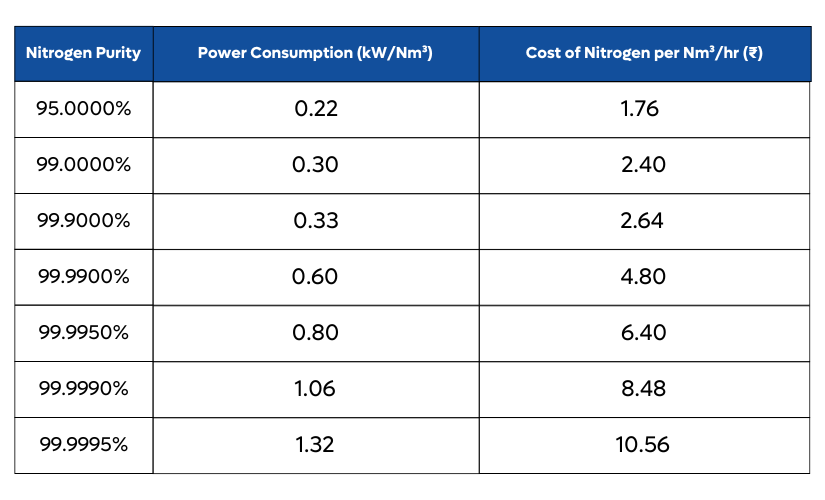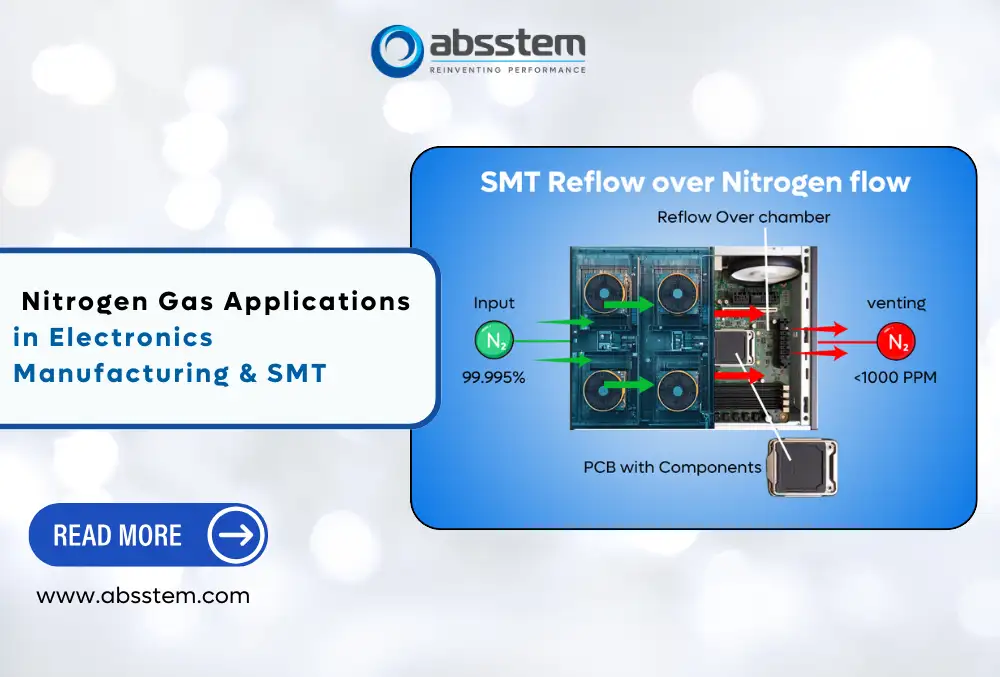When we talk about the application of a product like nitrogen gas in electronics manufacturing, several questions come to our minds. In this blog, we will answer the most common questions regarding the usage of Nitrogen gas. Without further ado, let’s dive into them.
Q: What is SMT and how does it use nitrogen?
Surface Mount Technology (SMT) is a precise electronic component mounting process that occurs in a reflow oven chamber. During this process, nitrogen is continuously purged to maintain oxygen levels below specified thresholds. The process involves mounting components directly onto a PCB’s surface, where controlled nitrogen atmospheres are critical for optimal soldering results.
Q: Why, specifically, is nitrogen used in electronics manufacturing?
During mounting of an electrical component, oxygen is required to be displaced from the reflow oven, a non-reactive or inert gas is the ideal solution for this application. Nitrogen being the most abundant inert gas in the atmosphere, serves as the most economical solution.
Nitrogen serves multiple functions in electronics manufacturing:
- Displacement of oxygen from the reflow oven to prevent oxidation
- Enhances solder joint quality by reducing void formation and dross accumulation
- Improves wettability, leading to reduced solder paste consumption
- Aids in thermal management during the heat-generating soldering process
Apart from Nitrogen, can we use other gases for SMT?
The answer is yes. Theoretically, other inert gases like argon and helium can also be used. However the difference lies in the cost of production of these gases.
Cost of production of Nitrogen ~ 100 times < Cost of production of ArgonCost of production of Nitrogen ~ 1000 times < Cost of production of Helium
Therefore, Nitrogen becomes the best solution. The reason for the low cost of production of nitrogen is the availability of abundant nitrogen (78%) in the atmosphere.
To understand more about the cost of production of nitrogen via PSA nitrogen generators, please read this blog (1).
Q: What is the purity of Nitrogen required for SMT?
Nitrogen purity requirements for SMT applications fall within 99.95-99.995% (equivalent to 50-500 PPM oxygen content). The reflow oven atmosphere must maintain oxygen concentration below 1000 PPM to ensure optimal soldering conditions and prevent oxidation defects. This specified purity range provides the necessary inert environment while balancing operational costs.
Note: PPM (parts per million) conversion
99.95% purity = 500 PPM O₂
99.995% purity = 50 PPM O₂
To get more clarity about the purity of nitrogen gas, please read our blog (1).
Q: How much Nitrogen is required for SMT?
Generally, 30 to 40 Nm3/hr Nitrogen gas is required in one reflow oven. This requirement varies according to the OEMs of SMT lines as well so please check with the OEM to get the exact requirement of Nitrogen.
Q: What is the Nitrogen pressure required for Electronics manufacturing?
Pressure of nitrogen gas around 1.5 Kg/cm2g is required in SMT lines but certain reflow ovens in SMT lines require 8 Kg/cm2g.s. Please check with the OEM of the SMT line to know the exact Nitrogen pressure requirement
Q: What are the different sources of nitrogen for electronics manufacturing?
Traditionally, liquid nitrogen tanks or nitrogen cylinders were used as a source of nitrogen gas for purging in SMT lines, but with advancements in technology, Nitrogen nowadays is produced on-site via PSA industrial nitrogen generators which separate nitrogen from atmospheric air.
The cost of nitrogen reduces drastically when produced via a PSA nitrogen generator. The below table shows the cost of Nitrogen by different sources:

We’ve spoken in depth about the cost of various sources of Nitrogen in our blog titled How to calculate the ROI (Return on Investment) of PSA Nitrogen Generator compared to Liquid Nitrogen or Nitrogen Cylinders (2).
Q: Can high-purity nitrogen of 99.999% be used for electronics manufacturing?
In most cases, 99.95 to 99.995% nitrogen gas is used in SMT lines. This will cost you around ₹3.5-6.4/- per cubic meter when produced via PSA Nitrogen Generator.
The cost of nitrogen production via PSA technology varies significantly as we move from lower to higher purity. This is mainly because producing higher-purity Nitrogen requires more energy (High amount of compressed air).
For example, generating nitrogen at 95% purity requires significantly less power than producing nitrogen at 99.9990% purity, since removing the final traces of oxygen from the gas mixture is an energy-intensive process.
The table below shows how electricity consumption affects the cost of production of nitrogen at different purity levels, assuming the cost of electricity as ₹8/- per unit – as per our blog (1):

As the table shows, the power consumption—and consequently, the cost—increases as nitrogen purity rises.
For instance, producing nitrogen at 99.995% purity costs ₹6.4 per Nm³, whereas producing 99.9995% purity nitrogen costs ₹10.56 per Nm³. This significant difference highlights the need to carefully match the nitrogen purity level to the application requirements to optimize costs.
Q: Why are PSA Nitrogen Generators becoming the preferred choice for electronics manufacturing?
Compared to traditional sources of nitrogen gas like cylinders or liquid tanks, PSA nitrogen generators are far more beneficial for an application like purging in the reflow oven. Below are the benefits of a PSA Nitrogen generator over traditional sources like cylinders or liquid nitrogen:
- Compact Size – PSA Nitrogen generators of 30 Nm3/hr are compact and help save a lot of space compared to liquid tanks.
- Low-pressure Systems (Safe systems) – As PSA nitrogen generators produce nitrogen at a pressure of 5-6 Kg/cm2g which is 30 times less than the pressure stored in cylinders, PSA nitrogen generators are much safer compared to cylinders.
- Fully automatic systems – As advanced PSA nitrogen generators are completely automatic with auto stop and IDLE features, these systems prove to be a boon for users as clients can focus fully on the manufacturing process.
- In-house Nitrogen generation – As Nitrogen is produced on-site in PSA nitrogen generators from compressed air, there is no external dependency on 3rd party vendors and logistics for the refilling of gas like in this case, of cylinders or liquid tanks.
- Reduction in carbon emission – As nitrogen is produced onsite in PSA nitrogen generators there is no logistics involved hence carbon emission is negligible.
- Low cost of Nitrogen – Nitrogen produced by PSA nitrogen generators is at least 1.5 times cheaper than other sources.
Conclusion
Nitrogen purging in SMT lines is a critical process across electronics manufacturing industries. Nitrogen’s inert nature, cost-effectiveness, and availability make it a preferred choice over other inert gases like argon and helium.
While traditional nitrogen sources like liquid nitrogen and cylinders are still used, on-site PSA nitrogen generators have emerged as a cost-effective and sustainable alternative. Understanding the specific requirements of nitrogen for SMT lines allows industries to optimize operations and reduce expenses. For tailored solutions and cost-efficient nitrogen for SMT application setups, please schedule a consultation with us.
Contact Us
For tailored solutions and expert advice on Nitrogen usage in SMT, contact us:
- Email: [email protected]
- Phone: 1800 3010 3394
- Website: www.absstem.com
References
- Absstem Technologies. (2024). Understanding Nitrogen Purity in PSA Nitrogen Generators
- Absstem Technologies. (2024). How to calculate the ROI (Return on Investment) of PSA Nitrogen Generator compared to Liquid Nitrogen or Nitrogen Cylinders
